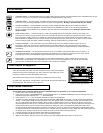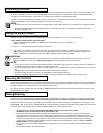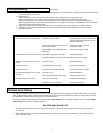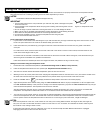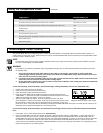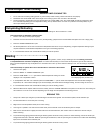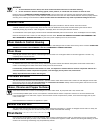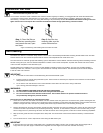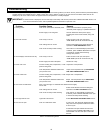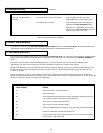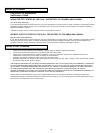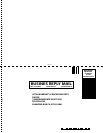
12
13
Step 1: Orient the filter so
that the two mounting tabs
are towards the rear, open
end down.
Step 2: Hook the two
mounting tabs over the
center horizontal bar.
Figure 16: Removing and Installing the Convection Fan Filter
Convection Fan Filter
WARNING
Remove the filter only when it is cool.
The convection fan filter is made of stainless steel. Remove the filter regularly for cleaning, as a clogged filter will reduce the effectiveness
of convection cooking modes. Soak the filter in hot soapy water. Dry the filter completely before re-installing. Remove the filter during
Self-Cleaning. If the filter is left in the oven during Self-Cleaning it will permanently discolor. Re-install the filter before cooking in the oven
again. Failure to do so will expose the convection fan blade that rotates at high speed during convection modes.
The electric door latch is a convenient safety feature. The door latch is automatically activated after selecting the Self-Clean mode. The latch
ensures that the oven door cannot be opened while the interior oven temperatures are unsafe to the user.
The oven features an automatic pyrolytic Self-Cleaning cycle to eliminate the need for difficult and time-consuming manual scrubbing of interior
surfaces. During this cycle, the oven reaches temperatures of 850˚F to burn off soil and deposits. A powder ash residue is left in the bottom
of the oven after completion of the Self-Clean cycle.
The Self-Clean time is variable from 2 to 4 hours to offer flexibility in handling various soil conditions. A 2-hour cycle normally handles a
moderately soiled oven, whereas a 4-hour cycle is recommended for a heavily soiled condition. The Self-Clean cycle can also be delayed
to start at a later time if desired.
IMPORTANT
If racks are left in the oven during a Self-Clean cycle, it will affect their ability to slide in and out easily. Polish the rack edges with a
soapy steel wool pad, then apply a small amount of vegetable oil to the edges so that the racks will slide more easily.
WARNINGS:
1. DO NOT OPERATE THE OVEN LIGHTS IN THE SELF-CLEAN MODE.
2. Do not touch the outside surfaces of the oven during the Self-Clean cycle
3. Do not use commercial oven cleaners inside the oven. Use of these cleaners can produce hazardous fumes or
can permanently damage the porcelain finishes.
Prepare the oven for Self-Cleaning by following these steps:
1. Clean soil from the oven front frame area and the oven door outside of the door gasket. Do not clean the door gasket. Cleaning the door
gasket by hand can cause it to bend or move. A tight door seal is essential for proper baking and Self-Cleaning. Rinse surfaces well with a
solution of vinegar and water, then wipe dry. Heavily soiled areas may be cleaned with a non-scratching scouring pad.
2. Remove the broiler pan and grill, all cookware, utensils and other loose items from the oven chamber. Also, remove all oven racks and the
convection fan filter to prevent them from permanently discoloring. However, to clean stubborn particles in the convection filter you may
elect to simply leave it in place during self-clean. The filter will discolor due to the high heat, but this will not harm the filtering capabilities
3. Wipe up excess grease and other food spills with a damp cloth. This will minimize smoke and increase the efficiency of the Self-Clean
cycle.
4. Turn on kitchen fans or vents to help remove odors during the Self-Clean cycle.
IMPORTANT:
1. It is normal for some smoke to be emitted during the first few Self-Clean cycles.
2. Popping sounds are normal during Self-Clean cycles. These sounds are caused by the expansion and contraction of metal surfaces
during heat-up and cool-down.
3. Do not line the oven with aluminum foil or other materials. These items can melt or burn during a Self-Clean
cycle, causing permanent damage to the oven
Self-Cleaning




